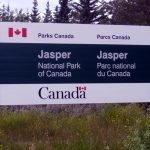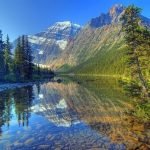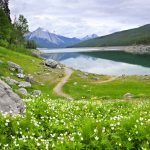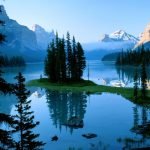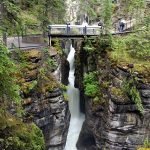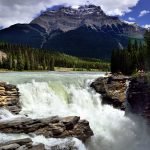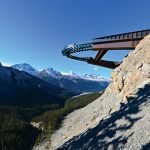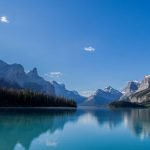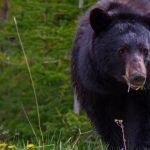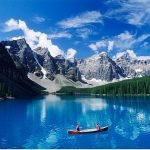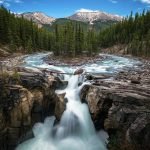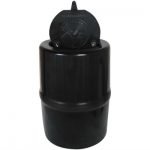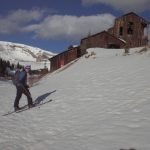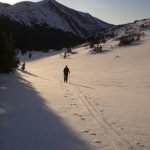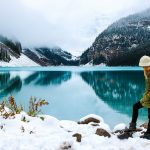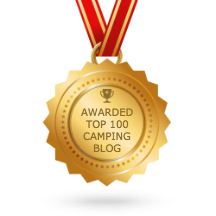The backbone of the Rocky Mountains, the Continental Divide, curves Northwest after you travel North of Casper, Wyoming through Montana into Canada. Jasper National Park is located in the province of Alberta, Canada. It is the largest national park in the Canadian Rockies and part of UNESCO’s Canadian Rocky Mountain Parks World Heritage Site. This national park extends more than 4247 square miles covering a large part of the Southwestern portion of Alberta. The park is made up of rugged mountains, deep valleys, glaciers, forests, alpine meadows, and rivers along the eastern slopes of the Rockies in Western Alberta. More than 615 miles of hiking trails offer day and overnight trips. A number of very special mountain drives exist here also. The park is open year-round, but the weather and scenery are the very best in late summer and early fall. Jasper National Park has about 2 million visitors per year.
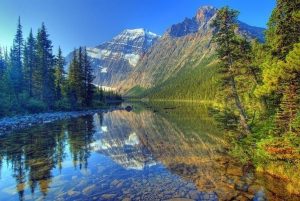
The park’s history is rich with the adventure of the fur trade and of exploration for a route to the West Coast, including David Thompson’s 1811 discovery of the Athabasca Pass and Northwest Company clerk Jasper Hawes’s establishment of a trading post near the present town of Jasper, Alberta. With the decline of the fur trade, Jasper House was abandoned in 1884. The Dominion Government established Jasper Forest Park in 1907. By 1911, the Grand Trunk Pacific Railway (now the Canadian National Railroad) had reached Fitzhugh (now Jasper) Station. The Jasper-Edmonton road opened in 1928. In 1930, Jasper Forest Park was officially established as a Jasper National Park.
Mount Columbia at 12,293 feet above sea level is the highest point in the Park and in Alberta. When you visit here you will also find the Columbia Icefield which is the largest icefield in the Rocky Mountains of North America. It is located in the Canadian Rockies astride the Continental Divide along the border of British Columbia and Alberta, Canada. The ice field lies partly in the northwestern tip of Banff National Park and partly in the southern end of Jasper National Park. It is about 125 square miles in area, 1,198 feet in depth and receives up to 280 inches of snowfall per year. The Athabasca Glacier is approximately 3.7 miles long, covers an area of 2.3 square miles, and is measured to be between 300–980 feet thick. Easily accessible, it is the most visited glacier in North America.
—- Location —-
The town of Jasper, which is the center of Jasper National Park is situated at the intersection of Highway 16 (Yellowhead Highway) and Highway 93 N (Icefields Parkway). It is straight west 225 miles on Highway 16 from Edmonton and West from Calgary along Trans-Canada 1, then north on Highway 93 from Lake Louise, 256 miles in total. Major national and international carriers service both Edmonton and Calgary’s international airports, with multiple flights arriving daily. Renting a car at the airport is the easiest way to make the trip, but rail travel to the park is also available through VIA Rail (think Canadian Amtrak).
—- Park Camping —-
Jasper National Park has 11 campgrounds with around 1,878 campsites. Most of these will accommodate RV’s and have electric service. Interestingly, some of these campsites also operate year around and advertise hot showers. Here is a list of the 11 campgrounds and what is available at each one. The Jasper National Park website does a nice job of explaining each campsite and how to make reservations (strongly encouraged) there. There are also 21 oTENTik located inside Whistler’s Campground They are canvas-walled tents, where you can ‘rough it’ without getting your clothes ruffled. Each oTENTik has all the basic comforts of home, wooden floors, bunk beds, sleeping pads, heat and lights. (Dress warm, they say the baseboard heating takes the chill off of the air). There are more than 100 backcountry camping sites which are described in the link. Jasper National Park offers two group campgrounds to choose from. They are Marmot Meadows and Whirlpool group camping. Both sites include large areas perfect for tenting, games and special activities for many people. Group campgrounds are most ideal for visitors with large groups such as Scouts trips, school trips, outdoor clubs or family reunions. Winter frontcountry and backcountry camping are also offered at several locations inside the Park.
—- Free Camping —-
Based on https://freecampsites.net/#!Jasper Alberta there are 16 free campsites located within 107 miles of Jasper, Alberta.
—- Area Camping —-
https://www.campendium.com/wapiti-campground-jasper-np
http://www.rvparkreviews.com/regions/alberta/jasper-national-park
https://www.goodsam.com/campgrounds-rv-parks/alberta/jasper/
https://www.allstays.com/Campgrounds/ab-jasper-campgrounds.htm
https://www.albertacampgroundguide.ca/campgrounds/hintonjasper-koa/
—- Hiking & Biking & Horseback Riding —-
Maligne Canyon is the deepest canyon in Jasper National Park, with a depth of more than 164 feet at certain points. Hikers of all abilities can explore this incredible natural landmark by crossing six bridges built across various points of the canyon. There are several historical trail networks that have been expanded and maintained for everyone wanting to experience Jasper’s wilderness. Take the Red Squirrel Trail from town to Old Fort Point, walking alongside the glacier-fed Athabasca River. The viewpoint at the top overlooks the town and many of Jasper’s iconic valleys and peaks. Lake Edith and Lake Annette are a short jaunt from town and a world away from city life. Take the Bighorn Alley Trail and bring your swimsuit. Soak in some beach time under snow-capped peaks. The paved trail around Lake Annette is wheelchair accessible. Trails along the Pyramid Beach are open year-round. Jasper has a great mountain bike trail system. Ask any cyclist why they come back to Jasper, and you’ll likely hear that it’s because the park’s well-connected, well-maintained trails are the perfect way to actually experience nature while at the same time avoiding crowds. Road biking is also allowed through most of the Park. Horseback riding is permitted at most but not all Jasper National Park trails.
https://www.pc.gc.ca/en/pn-np/ab/jasper/activ/activ-experience/sentiers-trails
https://pcacdn.azureedge.net/-/media/pn-np/ab/jasper/WET4/pdf/visit/
https://pcacdn.azureedge.net/-/media/pn-np/ab/jasper/WET4/pdf/visit/
http://www.jaspernationalpark.com/activities/summer-tours/horseback-riding
http://jasperstables.com/Trail-Rides.html
—- Things to Do —-
Take the SkyTram which is a great place to start since you get to look out over downtown Jasper and the surrounding area and it gives you a great feel for where you are. The tram holds 26 people and there is a guide that talks you through what you are seeing and where you are going. Take a boat cruise of Maligne Lake and then you get to stop and get off to explore Spirit Island which is located at the far end of the lake. There are a handful of glaciers that you can see from the cruise and due to the number of glaciers and where they are, the water color gets more and more of that aquamarine color as you get closer to Spirit Island.
https://www.pc.gc.ca/en/pn-np/ab/jasper/activ
https://www.crazyfamilyadventure.com/jasper-national-park/
https://www.jasper.travel/things-to-do/
https://www.todocanada.ca/top-places-visit-jasper-national-park/
https://www.jasper.travel/blog/10-tips-plan-perfect-jasper-summer-adventure-1/
—- References —-
https://www.pc.gc.ca/en/pn-np/ab/jasper
https://en.wikipedia.org/wiki/Jasper_National_Park
https://commons.wikimedia.org/wiki/Category:Jasper_National_Park
http://www.jaspernationalpark.com/
https://www.travelalberta.com/ca/places-to-go/national-parks/jasper-national-park/
- SONY DSC
